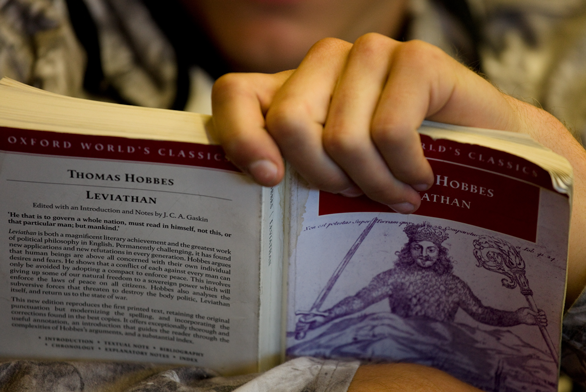A Polity That Binds: The Contrarianism of Intellectual Consensus at St. John’s
December 14, 2022 | By Salomon Cordova (SF22)

In 2018 St. John’s College was labeled “The Most Contrarian College in America” by New York Times columnist, Frank Bruni. In the column, Dean Walter Sterling said, “Education should prepare you for all of your life. It should make you a more thoughtful, reflective, self-possessed and authentic citizen, lover, partner, parent and member of the global economy.” The story was initially run as part of the college’s Freeing Minds campaign, a fundraising initiative which has brought the school more fiscal security than it has had in recent decades. One may wonder, however, beyond campaign slogans, how is St. John’s actually a bastion that preserves the contrarian mindedness, echoed in Sterling’s words, that is liberal education in America?
Rewind to the 1945 instituting of the college’s first Polity by Stringfellow Barr, founder of the New Program and then college president. Barr’s declared aim was to establish a “polity that might service the college community best and would be appropriately adapted to and coordinated with the aims of the program.”
Keeping in line with Barr’s vision, the current version of the Polity states that “The College is in actuality a conglomerate consisting of the Board of Visitors and Governors, the faculty, all students, alumni, and staff, as well as individuals specially named by the board.” Such a democratic standard far exceeds the norm for most college polities, which are commonly centralized around a clearly defined executive office. The contrarian disposition of St. John’s becomes clearer when we consider the fact that most colleges are focused on industry-centric goals.
Instead, the purpose of the New Program is “to train up and perpetuate a succession of able and honest men for discharging the various offices and duties of life, both civil and religious, with usefulness and reputation.” In other words, to inculcate a civic mindedness in the student, both traditional and nontraditional, so that they may become better human beings.
So how exactly does the Polity and Program of St. John’s cohere? As tutor and water resources lawyer Martha Franks (SF78, EC17) puts it, “the uniqueness of our contrarianism is a creative, original, and adaptive endeavor to preserve and integrate the intersection of STEM and the humanities. It is the consideration that human problems have always been an aspect of understanding the world and how to apply that knowledge to living the best life possible.” And that “we achieve this through a polity designed to promote conversation and avenues of consensus among everyone who experiences the program.” In this light, the contrarian identity of the college manifests as a civic responsibility for furthering the transformational dialectic that is at the core of the New Program.
To those who are not familiar with the educational perennialism that is the program of instruction and the way it bleeds into the operations of the Polity, this may appear as a goal that is too idealistic and ungrounded pragmatically. But that concern is exactly why St. John’s succeeds. Diego Salinas (SF24) says that “even though it is difficult to live up to the equality inherent in such an aim it is precisely through the collective goodwill effort to maintain democratic dialogue that a unified experience and identity is achieved, and this kind of collective unity is what makes St. John’s such an attractive place. In almost no other institute of higher learning do you find an administration working so consciously to foster inclusivity among all levels of its organization.”
That kind of intellectual perennialism is possible only because, as longtime Annapolis tutor Brendon Lasell explains, the core of the polity is constituted in order to support our community of purpose. Since it charges both the students and tutors with the same basic responsibility, to learn through the Program, the other offices are free to organize around that idea. Further, it allows the program to flourish as a study that simply focuses on the intelligible aspects of the human imagination and how they have been communicated among people across time.”
To sum up, the richness of the conversations that happen across the college is a reflection of a Polity designed to preserve and further the greatest ideas of human achievement. However, as studies of the Great Books show us, humanity often falls short of their lofty aims.
But by employing the more classically liberal method that forces individuals to think outside the artificial distinctions of the disciplinary studies that have become so commonplace in higher education, the community of St. John’s College has moved beyond those boundaries and has opened up a space for an explosion of creative thought that can only be understood, against the backdrop of contemporary academia, as intellectually diverse and inherently contrarian.

